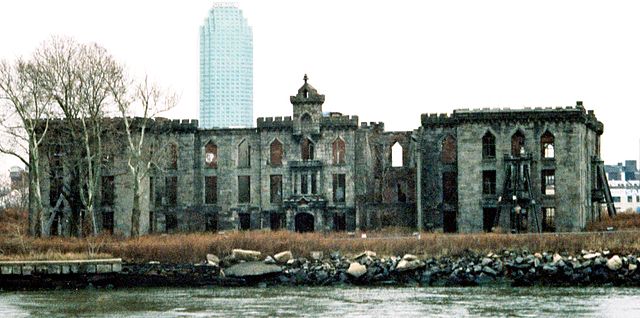Archive for the ‘Culture and History’ Category
June 3, 2018 in Culture and History | Comments (0)
Tags: Coney Island Boardwalk, NYC Landmarks, Scenic Landmarks
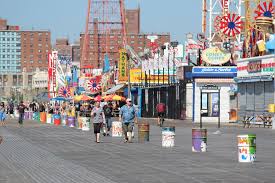 New York City has just designated Coney Island boardwalk as a Scenic Landmark in honor of its 95th birthday on Tuesday. Opened in 1923, the promenade is now 2.7 miles long.
New York City has just designated Coney Island boardwalk as a Scenic Landmark in honor of its 95th birthday on Tuesday. Opened in 1923, the promenade is now 2.7 miles long.
The spot, which has drawn both locals and tourists with its sandy beaches, eateries and amusement park rides for over a century, has undergone many changes over the years. According to the New York City Landmarks Preservation Commission, sections of the boardwalk have seen been redone in concrete, wood and recycled plastic.
Commission Chair Meenakshi Srinivasan said: “It is a beloved public space that embodies Coney Island’s demographic spirit and reflects our city’s values of tolerance, inclusivity and equity.”
Parks Commissioner Mitchell J. Silver added “Coney Island’s boardwalk is a timeless treasure. With it’s rich history, I am confident that with this designation, it will stand and serve this city and its visitors for hundreds of years to come.”
May 24, 2018 in Culture and History | Comments (0)
Tags: Cultural Events, New York Chinese Lantern Festival, NYC Events, Syracuse
The New York Chinese Lantern Festival is hitting the New York State Fairgrounds this weekend, complete with 1,000 Chinese lantern sculptures in a wide range of themes from Tianyu Arts in Zigong, China. 30 craftspeople, primarily from Chengdu, will join the show to assemble and maintain the sculptures through July. Chengdu, the capital of Sichuan Province, is known for its prowess in the ancient art of lantern-making, which has become a family tradition in the region.
The lantern show will also feature a number of additional acts, including traditional Chinese acrobatics, plate spinning and face changing.
The event, which is sponsored by Advance Media New York, visited NYC last year as well and has made some improvements to this year’s happening. Instead of gravel paths, the entire show will take place on paved walkways, allowing for easier access for wheelchairs and strollers. The show will take place both indoors and outdoors, to protect visitors from the elements in case of unpleasant weather, now near and inside the International Pavilion and Horticulture Building. All acts will be performed inside the International Pavilion instead of outdoors, and additional seating will be available as well as additional shows on the weekends.
March 6, 2018 in Culture and History | Comments (0)
Tags: Beax-Arts Kiosk, Nathan Hale, Roosevelt Island, Saint Vartan Armenian Cathedral
It might not feel like winter is winding down, but eventually spring must arrive, right? So, we might as well get ready now with a few unusual New York City attractions.
Saint Vartan Armenian Cathedral
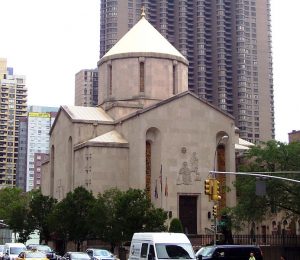
St. Vartan Armenian Cathedral, located at 620 Second Avenue at 34th Street, in the Kips Bay neighborhood of Manhattan, New York City, was built in 1966-1968 and designed by Steinmann & Cain. Photo courtesy of Beyond My Ken.
Smack in the middle of Manhattan’s towering high-rises sits a modest church which is a replica of a cathedral built during the 7th century in Armenia. Looking like a misplaced dwarf, this replica of the Saint Hripsime Church, built in 681 AD, was itself built in 1966. There is a lot to see here, but we will merely suggest taking note of the unique to Armenian architecture feature of double-intersecting arches inside, which allow the building to stand without the need of columns, which are pervasive in most other churches. Located at Second Avenue between 34th and 35th Streets.
The Spot Where Nathan Hale Said His Famous Last Words
Famously hanged by the British on September 22, 1776 for spying on behalf of the (American) rebels, Nathan Hale is mostly remembered for his brave declaration that, “I only regret that I have but one life to lose for my country.” According to one British officer’s diary, the hanging happened at “the Royal Artillery Park near Dove Tavern at the old Post Road,” now Third Avenue. Unfortunately, exactly where the “British Artillery Park” was located is in dispute, and therefore there are two plaques claiming to be the true spot where Hale was hanged. One plaque is found at Third Avenue between 65th and 66th Streets, and the second is hanging on the Yale Club (Hale’s alma mater) at 44th Street and Vanderbilt Avenue.
Beaux-Arts Kiosk at Trolley to Welfare (Roosevelt) Island
Five ornately decorated kiosks were built in 1909 servicing a trolley line from Second Avenue in Manhattan to Queens on the other side of the East River via the Queensboro bridge. There was one stop on Welfare Island, known today as Roosevelt Island, where passengers disembarked from the trolley and took an elevator down to the island, known as Welfare Island due to the preponderance of hospitals there. In 1957 three of the kiosks were sadly destroyed. A fourth was moved in the 1970s to the Brooklyn Children’s Museum, but faced again with the possibility of destruction, was once again moved back to Roosevelt Island, were it serves as a visitor center. The last kiosk is still in its original location at 59th Street just under the bridge and tramway to Roosevelt Island. It now sits on a traffic island under the bridge, lonely and forlorn. There is no question your visit would be appreciated.
November 19, 2017 in Culture and History | Comments (0)
Tags: Macy's Thanksgiving Day Parade
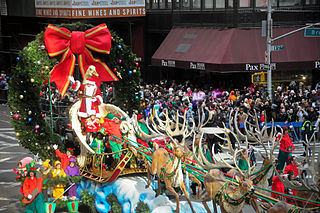
Santa Claus at the Thanksgiving Day Parade. Photo by tweber1.
You have most likely been watching the Macy’s iconic Thanksgiving Day Parade since you were just a wee thing, but methinks there are many facts about the parade you do not know. So just so that your enjoyment level is set to high this coming turkey day, here is a list of fun facts you most likely had no idea about, and didn’t even know that you cared about, until now.
1. The Macy’s Thanksgiving Day Parade was launched for the first time in 1924, making it the second oldest of them all.
2. The first few parades were called “Christmas Parades” even though they took place on Thanksgiving. Go figure.
3. The first parade featured camels, monkeys, elephants and bears from the Central Park Zoo.
4. From 1928 until 1932 it was easier to just let the giant balloons fly away then to take them down and deflate them, and that is exactly what they did.
5. Today’s parade requires and enormous number of behind-the-scenes workers- to prepare the 4,000 volunteers for the parade requires 230 dressers and 100 make-up artists.
6. Those balloons require huge amounts of helium. Only the US government uses more each year.
7. Handling those balloons is not easy. “Balloon pilots must walk backwards the entire 2.5 mile parade route.
8. Not just people, but balloons can also serve their country. During WWII the gigantic balloons were donated to the government to provide much needed rubber.
9. The scenes of the Thanksgiving Day Parade which are included in the classic movie Miracle on 34th Street were shot of the actual 1946 edition of the parade.
August 10, 2017 in Culture and History | Comments (0)
Tags: Hudson Park, Lusitania, Pier 54, Pier 59, Titanic
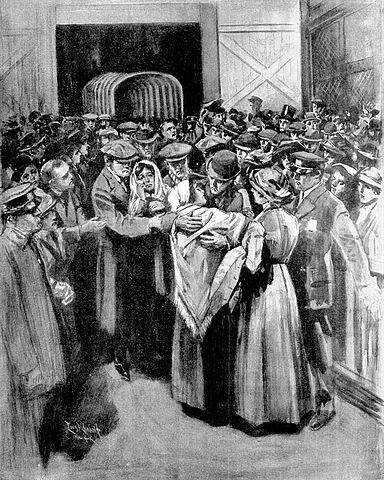
Arrival of the “ship of sorrow” at New York. Drawing by L.F. Grant (Boston Globe artist)
A sad bit of New York history awaits visitors who would like to see the place where the survivors of the Titanic finally disembarked at the end of their tragic journey from Europe to the United States.
The Titanic, if it had made it until the end of its maiden voyage without sinking in the middle of the Atlantic Ocean after striking an iceberg, would have docked at Pier 59 on the Hudson River. Instead, the survivors were rescued by the Carpathia and brought back to New York to disembark at Pier 54 just a few blocks south of Pier 59. About 40,000 people were waiting at the dock to great the survivors, or to hear the terrible news that a friend or loved one had not made it home alive.
A mere three years later, in 1915, a ship called the Lusitania departed from the very same Pier 54. It was torpedoed by a German U-boat off the coast of Ireland, sinking only 20 minutes later with almost the all 2000 of its passengers and crew on board.
Today the pier is part of Hudson River Park. There are several plans to restore the pier to how it looked in the early 20th century, but so far none have come to anything. Visitors today will find an empty strip of metal and concrete reaching out into the waters of the Hudson River, a dark reminder of the sad history written there.
The story of the Titanic seems to have only grown over the years, but interest in the pier seems to be fading instead.
September 8, 2016 in Culture and History | Comments (0)
Tags: abandoned cats, Island Cats, Renwick Smallpox Hospital, Roosevelt Island
People who are passionate about cats will no doubt be love a visit to the Cat Sanctuary which was established on Roosevelt Island. The island had been a traditional dumping ground for unwanted cats long before the establishment of this refuge for refugee cats, but it is now an offical safe haven for the numerous cats whose owners will not or cannot take care of them anymore.
For as long as people in these parts can remember the presence of cats on the island was tolerated, and sometimes even encouraged, as good Samaritans left food and water for the numerous strays and homeless cats that called Roosevelt Island their home. When a cat named Yin Lang died in 2004, his demise inspired a group to form, called Island Cats. Eleven years ago, in 2005, the group decided it was time to do something to help the cats there, protect them and even find homes for them.
Island Cats began by to trapping and neutering the strays, and they created an adoption program for them. On the southern tip of the island the group operates a small shelter.
The cats have the distinction of being the only creatures allowed into the ruins of the Renwick Smallpox Hospital. One day however the hospital may be re-opened, but not until its structure is reinforced.
A good place to observe the cats of Roosevelt Island is near the ruined Renwick Hospital.
March 5, 2016 in Culture and History,Theater | Comments (0)
Tags: Lincoln Center, New York Public Library for the Performing Arts, Shakespeare
From now until May 14 Lincoln Center is hosting a wonderful free event: Artists for LPA Share Shakespeare. Taking place at the New York

This was long thought to be the only portrait of William Shakespeare that had any claim to have been painted from life, until another possible life portrait, the Cobbe portrait, was revealed in 2009.
Public Library for the Performing Arts, come hear the answers actors, comic, musicians, designers and songwriters give to some intriguing Shakespearean questions, such as: “What is your favorite Shakespeare play or character? Your least favorite? Your favorite actor or production?” In other words, “How did Shakespeare inspire you?”
The event is completely free at 10:30am every day but Sunday. Not tickets needed. When you visit The Library you will see their answers paired with artifacts from the library’s collections.
The New York Public Library for the Performing Arts, Dorothy and Lewis B. Cullman Center, Plaza Corridor Gallery is right next to Lincoln Center at 65th Street between Amsterdam and Columbus Avenues.
May 5, 2015 in Art,Culture and History | Comments (0)
Tags: Calvery Vaux, Central Park, Central Park Conservancy, Drifting in Daylight, Frederick Law Olmsted, Harlem Meer, Huddlestone Arch, north end, the Loch
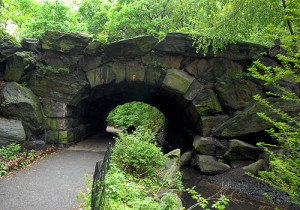
Huddlestone Arch
From May 15 until June 20, 2015, on Friday’s and Saturdays at 12pm, visitors to Central Park can explore the less well-known north end of the park. The non-profit public arts organization known as Creative Time, along with the Central Park Conservancy is sponsoring a tour which will follow a winding pathway to some of Central Park’s more wonderful features.
Participants will visit the Harlem Meer, Great Hill, and the Conservatory Garden. Along the meandering path a wonderful selection of innovative art works will come into view, created specifically for Central Park and its unique landscape.
The tour is free, and is the key event of the Central Park Conservancy’s 35th Anniversary celebration.
Other features of the north end of the park include Huddlestone Arch, the Harlem Meer and the Loch. Many consider the Huddlestone Arch the most surprising of the park’s many arches. Designed in 1866 by Calvery Vaux, it is built without the use of mortar or any other binding material. Only gravity and pressure are holding this arch together.
The Harlem Meer, designed by Frederick Law Olmsted and Vaux is a man-made lake which memorializes what was the separate village of Harlem. Fishing in permitted in the lake and visitors can expect to see turtles, waterfowl as well as fish in the thriving habitat created by the Meer, which means ‘lake’ in Dutch.
The Loch, which is the Scottish word for ‘lake,’ winds through the Ravine. It is fed by a natural watercourse and flows under Glen Span and Huddlestone arches and then connects to the Meer. The stream was also designed by Olmsted and Vaux, and has several dams creating three beautiful waterfalls.
If you haven’t been to Central Park recently, or even if you have, it’s always an invigorating experience to explore the many beautiful features of this incredible New York wonder.
February 5, 2015 in Culture and History | Comments (0)
Tags: Center for the Holographic Arts, Holocenter, Holography
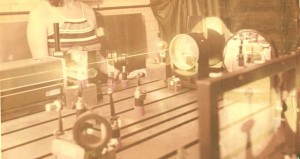
An optical table being used to make a hologram. Photo by Epzcaw
The Holocenter, or otherwise known as the Center for the Holographic Arts, is New York’s showcase for this unique and fascinating art form. Established by respected holographic artists Ana Maria Nicholson and Dan Schweitzer in 1998, the mission of the Holocenter is to “bring virtual understandings into contemporary dialogues around media participation, technology and visual-spatial information.”
The Center has an office at Flux Factory in Long Island, and a public gallery on Governors Island at the Holocenter. The staff of the Holocenter work together with artists, helping them to develop concepts and providing several holography studios. The Pulse Laser Studio is located at Ohio State University, and the New York Holgraphic Laboratories is in Manhattan.
Visitors can attend artist talks, workshops, or see the center’s publications to learn more about holography. The center is now located in a late 19th century house on Governor’s Island with limited hours, so check before you visit.
January 6, 2015 in Culture and History | Comments (0)
Tags: Ada Louise Huxtable, City Hall, Free Guided Tours
Maybe you can’t fight city hall, but you sure can visit. Located across the street from the entrance to the Brooklyn Bridge in City Hall Park, the building has been the seat of the city’s government since 1812. The original building was a marble hall with a cupola, except for the northern side, which was done in brownstone to save money on the construction.
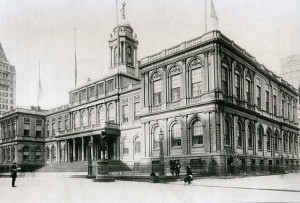
City Hall in 1919.
In 1917 the domed tower was rebuilt after two fires severely damaged it. Almost 40 years later, from 1954-1956 the original marble and brownstone facades were replaced with a granite base covered with limestone. The quality of the restoration inspired critic Ada Louise Huxtable to exclaim that City Hall was now a “symbol of taste, excellence and quality not always matched by the policies inside.”
A tour, which is free, will take you into the space under the soaring rotund which is held up by 10 Corinthian columns. There is a reception space where the mayor visits with important guests, which has 12 paintings of the founding fathers by John Trumbull. With a guided tour offered by the Art Commission of the City of New York, which is also free, you can visit the grand interior of the building. Call first for reservations.
For city hall call: 212 788 6865
For Guided tours call: 311
For more information go to: http://www.nyc.gov/html/artcom/html/home/home.shtml
« Newer Posts Older Posts »
 New York City has just designated Coney Island boardwalk as a Scenic Landmark in honor of its 95th birthday on Tuesday. Opened in 1923, the promenade is now 2.7 miles long.
New York City has just designated Coney Island boardwalk as a Scenic Landmark in honor of its 95th birthday on Tuesday. Opened in 1923, the promenade is now 2.7 miles long.


